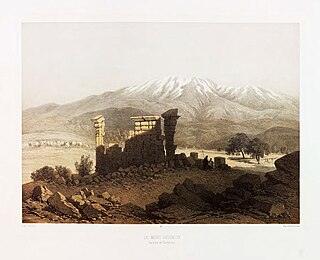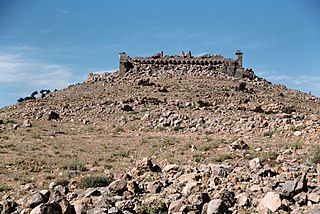
Mount Hermon is a mountain cluster constituting the southern end of the Anti-Lebanon mountain range. Its summit straddles the border between Syria and Lebanon and, at 2,814 m (9,232 ft) above sea level, is the highest point in Syria. On the top, in the United Nations buffer zone between Syrian and Israeli-occupied territories, is the highest permanently manned UN position in the world, known as "Hermon Hotel", located at 2814 metres altitude. The southern slopes of Mount Hermon extend to the Israeli-occupied portion of the Golan Heights, where the Mount Hermon ski resort is located with a top elevation of 2,040 m (6,690 ft). A peak in this area rising to 2,236 m (7,336 ft) is the highest elevation in Israeli-controlled territory.
Deir El Aachayer is a village north of Rashaya, in the Rashaya District and south of the Beqaa Governorate in Lebanon.

Hebbariye, Hebbariyeh, Hebbariya or Hebariya is a village and municipality situated in the Hasbaya District of the Nabatieh Governorate in Lebanon. It is located on the southwestern slopes of Mount Hermon near the Lebanon–Syria border, northeast of Rachaya Al Foukhar and is positioned amongst orchards of apricot trees. There it is a roman temple.
Kiboreia is a location that is known from a Greek inscription taken from a large temple at Deir El Aachayer on the northern slopes of Mount Hermon in Lebanon.

Nebi Safa, Nabi Safa, Neby Sufa, An Nabi Safa, An Nabi Safa' or En Nabi Safa also known as Mazraet Selsata or Thelthatha is a village in the Kfar Mishki municipality situated 13 kilometres (8.1 mi) west of Rashaya in the Rashaya District of the Beqaa Governorate in Lebanon.
Aaqbe, Akbeh, Aqbe, Akbe, Aaqabet, el-Aaqbe, Akraba, Aaqabet Rashaya or Akabe (العقبه) is a village and municipality situated 3 kilometres (1.9 mi) west of Rashaya in the Rashaya District of the Beqaa Governorate in Lebanon.
Khirbet El-Knese, El-Knese or El Knese are two Roman temples south of Yanta, north of Rashaya in the Rashaya District of the Beqaa Governorate in Lebanon.
Bakka, Bekka or Beka is a village and municipality situated 85 kilometres (53 mi) east of Beirut in the Rashaya District of the Beqaa Governorate in Lebanon. The population of the village is Sunni.
Rakhlah, previously known as Zenopolis, is a village situated 31 kilometres (19 mi) west of Damascus, Syria. also known as "The town of Wine and Poetry".

Burqush or Burkush is an archaeological site situated 30 kilometres (19 mi) west of Damascus, Syria.
Qal'at Bustra or Qalat Bustra is an archaeological site in Lebanon, close to the border of the Sheba Farms region of the Israeli-occupied Golan Heights, about 5 km ENE of Ghajar. It is situated on a peak of height 786m with a panoramic westward view. Qal'at Bustr is believed to be an ancient Roman sanctuary and was excavated by Israeli archaeologists. Remains found at the site include a farmhouse and temple dating from the Hellenistic and Roman period.

Har Senaim or Senaim, is an archaeological site that sits on a peak near Mount Hermon in the Israeli-occupied portion of the Golan Heights, 15 kilometres (9.3 mi) north east of Kiryat Shmona and 4 kilometres (2.5 mi) from Banias.

Ain Aata, Ain Ata, 'Ain 'Ata or Ayn Aata is a village and municipality situated southwest of Rashaya, 99 kilometres (62 mi) south-east of Beirut, in the Rashaya District of the Beqaa Governorate in Lebanon.
Jdeidat Yabous, previously known as Ainkania, is a village situated 45 kilometres (28 mi) west of Damascus, Syria. According to the Syria Central Bureau of Statistics, the village had a population of 994 in the 2004 census.
Qasr Chbib is a complex of two Roman temples situated a few hundred meters from the summit of Mount Hermon. Officially in the Quneitra District of Syria, Web mapping shows the ruins to be in the Hasbaya District of the Nabatieh Governorate in Lebanon.

The Temples of the Beqaa Valley are a number of shrines and Roman temples that are dispersed around the Beqaa Valley in Lebanon. The most important and famous are those in Roman Heliopolis. A few temples are built on former buildings of the Phoenician & Hellenistic era, but all are considered to be of Roman construction and were started to be abandoned after the fourth century with the fall of the Roman Paganism.
The Nabataean religion was a form of Arab polytheism practiced in Nabataea, an ancient Arab nation which was well settled by the third century BCE and lasted until the Roman annexation in 106 CE. The Nabateans were polytheistic and worshipped a wide variety of local gods as well as Baalshamin, Isis, and Greco-Roman gods such as Tyche and Dionysus. They worshipped their gods at temples, high places, and betyls. They were mostly aniconic and preferred to decorate their sacred places with geometric designs. Much knowledge of the Nabataeans’ grave goods has been lost due to extensive looting throughout history. They made sacrifices to their gods, performed other rituals and believed in an afterlife.

Qalaat Faqra is an archaeological site in Kfardebian, Lebanon, with Roman and Byzantine ruins. Located near the Faqra ski resort on the slopes of Mount Sannine at an altitude of 1500 m, it is one of the most important sites of the UNESCO-listed valley of Nahr al-Kalb.

The Roman temple of Bziza is a well-preserved first century AD building dedicated to Azizos, a personification of the morning star in the Canaanite mythology. This Roman temple lends the modern Lebanese town of Bziza its current name, as Bziza is a corruption of Beth Azizo meaning the house or temple of Azizos. Azizos was identified as Ares by Emperor Julian.


















